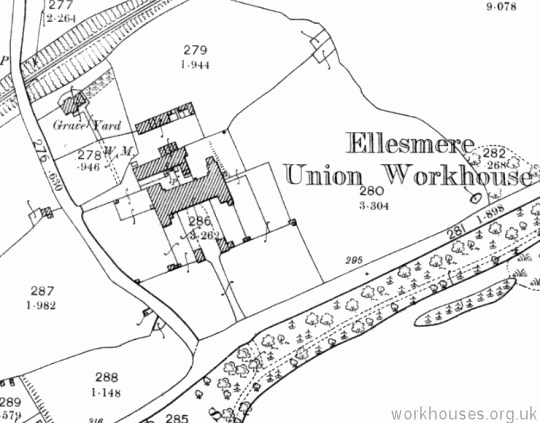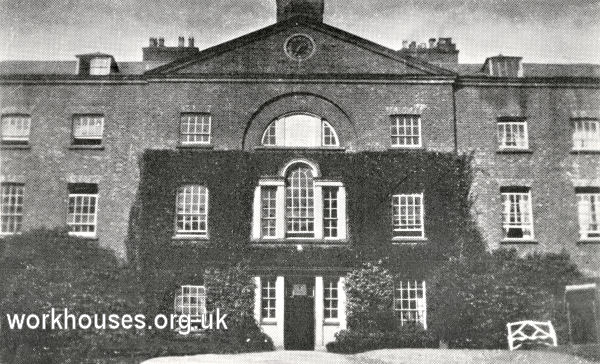Ellesmere, Shropshire
[Up to 1834]
[After 1834]
[Staff]
[Inmates]
[Records]
[Bibliography]
[Links]
The success of the Shrewsbury Incorporation, formed in 1784, led to the formation of a number of other such Incorprations in the area, including Atcham, Oswestry, Whitchurch, and Montgomery and Pool. Ellesmere, together with the parishes of Baschurch, Middle [Myddle], Hordley, and the chapelry of Hadnal [Hadnall] Ease, was incorporated under a local Act in 1791. The Act empowered the incorporation, among other things, to erect a workhouse which it did in 1791-2 at Swan Hill, Ellesmere — the location is sometimes referred to as Haughton. Ellesmere was the subject of a report by Eden in his 1797 survey of the poor in England:
The Poor of this parish, and of 4 others lately incorporated by an Act of Parliament, are chiefly maintained in a House of Industry opened in January, 1795. The distribution of the rooms, the bye-laws relative to the external concerns, and the regulations for the internal government of the house are very similar to those adopted at Shrewsbury. The number of inmates is 198, viz., 50 women, 34 men, and the rest children. Every article of wearing apparel is manufactured in the house; flannels also are made for sale, and a hop-bag manufacture has lately been set on foot. The house stands in an open healthy situation, on the banks of an extensive piece of water near the town. The dormitories are extremely clean and neat, and every appearance indoors evinces the unremitting assiduity of the governor to the duties of his situation. An instance of feeling attention to misfortune, which is not often to be met with in Houses of Industry, is shown in the provision of special apartments for persons who have borne a fair character, and have been undeservedly reduced from each circumstances and obliged to seek parish relief. All the family, however, dine together. Notwithstanding the promised advantages, it is said that the incorporated parishes are in general now heartily sorry they ever engaged in the erection of a House of Industry. The average annual disbursements of the five incorporated parishes for 12 years before 1790 were £1,421 13s. 3d. The expenses on account of the house from July 26, 1791, to September 29, 1795, were £11,100 9s. 4d., and the expenses for the Poor in 1795 will it is expected amount to £3,500. The assessments are 4s. 6d. in the pound on one-third of the rack rent. The corporation do not allow out-pay to any person under 70, and to persons above that age only 1s. a week. At present 30 families receive £1 10s. on this account. Children at nurse cost £3 a week, militia men's families about 18s. a week A farm of 45 acres, with four cows, is attached to the house.
A workhouse was also established by the parish of Overton. It was the subject of the following (abridged) 1832 report:
The workhouse of Overton, in Flintshire, is a very small and
incommodious building, little else than a brick cottage, without, however, a cottage's neatness. The parishes of Bangor and Worthinbury and the township and chapelry of Halghton and Penly, whose united population is 3,020, are in connexion with this house, and
pay a certain annual sum as rent, for the privilege of sending their poor there. Of this privilege little advantage is taken; and the house is chiefly used by the overseers as an instrument of compelling a good bargain with applicants for relief. The system of this establishment differs from that of [Forden and Hawarden], in that each pauper is farmed out at 2s. a week to a contractor, who besides is allowed the house and a few acres of land rent free; he is entitled likewise to all the labour he can extract from the inmates, which is no large quantity, as children and old people form the great majority of the paupers sent to the house. Of 13 that were there about the beginning of September 1832, only one was
between the ages of 12 and 60 years. There is no system of employment attached to the
establishment, but the present contractor is a brickmaker, and the paupers who are able, assist him in the manufacture. This and the occasional cleaning of the crops on his lands, vindicates, in a measure, the appellation of workhouse; in other respects, it is little else than a poor-house, for there is no distinction in diet; no separation of sexes further than what takes place in farm houses, and in short, no regulations. Nevertheless, the establishment is considered to have saved money,
After 1834
The Ellesmere Poor Law Union formally came into being on 14th November 1836, originally including only parishes from Salop (Shropshire). On 4 March 1837, the union was extended by the addition of 8 Flintshire parishes. Its operation
was overseen by an elected Board of Guardians, 22 in number, representing its
17 constituent parishes as listed below (figures in brackets indicate numbers
of Guardians if more than one):
County of Salop:
Baschurch (2), Ellesmere (5), Hadnall Ease, Hordley, Myddle, Great Ness, Little Ness, Pelton, Welsh Hampton.
County of Flintshire:
Bettisfield, Bronington, Halghton, Hanmer, Overton, Penley, Tybroughton, Willington.
Later Addition: Cockshutt (from 1896).
The population falling within the Union at the 1831 census had been 10,263 — ranging from Little Ness and Pelton (population 49 each) to Ellesmere itself (6,540). The average annual poor-rate expenditure for the period 1834-36 had been £4,666 or 9s.1d. per head of the population.
The new Ellesmere Union took over the existing workhouse at Haughton. It could accommodate 350 inmates and centred around a three-storey H-shaped main building, with males accommodated in the west wing and females in the east wing which also contained a chapel. The workhouse had its own graveyard at the north of the site. The workhouse location and layout are shown on the 1901 map by which time it had become known as Ellesmere Poor Law Institution:

Ellesmere workhouse site, 1901.

Ellesmere workhouse c.1920.
The buildings were demolished soon after the abolition of the workhouse system in 1930.
Records
Note: many repositories impose a closure period of up to 100 years for records identifying individuals. Before travelling a long distance, always check that the records you want to consult will be available.
-
Shropshire Archives, Castle Gates, Shrewsbury, Shropshire SY1 2AQ. Please note that records may contain gaps or have access restrictions - please check before visiting.
Holdings include: Records of numbers of inmates (1795, 1810, 1824); Guardians' minutes (1871-5, 1908-23); Ledgers (1928-30); Births and deaths (1866-1930); etc.
[Top of Page]
[Unions List]
[Unions Map]
[Home Page]




